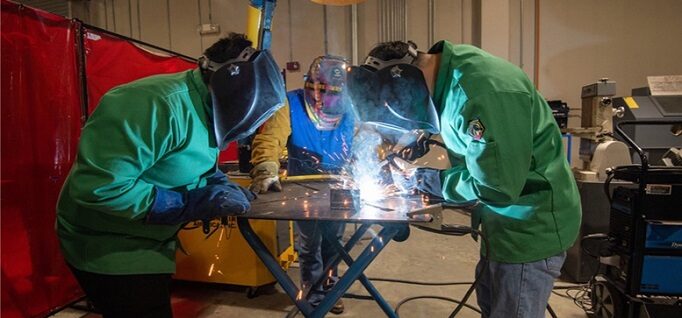Perfect storm leads to collaboration on workforce development
By Michele Hujber
May 31, 2023
New Jersey expects to add 78,300 new health services jobs by 2026. By 2028, the demand for technology and innovation workers will have increased by 6% from today’s 300,000. These industries and others rely on the state’s community colleges to produce enough graduates to fill these positions.
The New Jersey Council of County Colleges (NJCCC) and the New Jersey Business & Industry Association (NJBIA) have teamed up to ensure that the colleges are preparing students to fill anticipated job openings. To this end, they’ve created a new program, New Jersey Pathways to Career Opportunities. The initiative brings together community colleges, industry and workforce development partners to meet New Jersey’s workforce goals.
New Jersey has a decentralized system of 18 community colleges. NJCCC and NJBIA established 10 Centers of Workforce Innovation comprised of colleges working together to develop curriculum and new program models and partnerships as part of the Pathways program.
The centers have developed 22 career pathways. Each pathway aligns with industry and leads to a four-year degree. There are 1,200 partners, including industry as well as community colleges, high schools, four-year colleges and universities. They are developing pathways across health services, technology and innovation, infrastructure and energy, and manufacturing and supply chain management.
“We are very excited about the involvement of our colleges, but also with high schools, labor unions, employers for your colleges and universities,” says NJCCC President Aaron Fichtner.
The Pathways model
The Pathways model involves program and curriculum sharing among New Jersey’s 18 community colleges in a way that can retool to meet industry needs. Also, it involves meeting the needs of unemployed people by giving them access to an industry credential that makes them immediately employable. This strategy involves evaluating noncredit coursework or experience for credit and embedding industry credentials into both noncredit and credit programs.
Collaboration is critical to the Pathways model.
“Collaboration is very difficult, especially in an era where the pressure of enrollment and meeting your budget is so great,” notes Michael McDonough, president at Raritan Valley Community College. “Sharing is not in our institutional DNA.”
“There wasn’t a perceived need in the past for the level of collaboration that we have experienced for this initiative,” adds Catherine Frugé Starghill, NJCCC vice president and executive director of the New Jersey Community College Consortium for Workforce & Economic Development.
She cites factors such as declining enrollments; disinterested and emotionally and socially impacted high school students; and the large number of job vacancies in New Jersey as influencing the move toward collaboration.
“The pandemic brought the perfect storm,” Starghill says. “Education institutions, as well as industry, were ready, some might even say hungry, for an initiative that would align education to build an innovative workforce.”
Starghill notes that community colleges are often viewed as transfer institutions without focusing on workforce development.
“What we want to do with regards to the transfer to the four-year institutions is to align our curriculum better so that the four-year colleges will accept all, not just some, of the community college credits toward the bachelor’s degree,” she says, explaining that the strategy will help build employability at every educational level.
Building at one’s own pace
NJ Pathways also wants to ensure that credits are stackable at every level.
“Students can go through an eight-week program, go to work, come back, get the associate degree, and go on to get the baccalaureate degree,” says Anthony J. Iacono, president of County College of Morris (CCM). “It’s built to be stackable from an industry-credentialed short-term certificate to a master’s and doctorate level. If students want to go step by step while working, they can. This system is more reflective of today’s lifestyle and today’s work habits.”
Industry involvement is also crucial to the Pathways model.
“We work with global manufacturers like Weiss and Marotta Controls,” Iacono said. “And, we also work with groups like the New Jersey Manufacturing Extension Program and our chambers of commerce locally and across the state.”
Year-one accomplishments
Each month, the industry and education partners of the four collaboratives focus on a specific workforce development and postsecondary higher education concept. There have been forty-three collaborative meetings. And, the education partners in the 10 Centers of Workforce Innovation have completed 22 education and training pathways.
Collaboration is hard work. The outcomes to date include dual-enrollment programs, new articulation agreements between community colleges and four-year colleges and universities, and reimagined workforce training programs.
“What’s been most exciting is to see three or four colleges coming together and saying, ‘What can we do together to make sure we have state-of-the-art data science curriculum or patient care initiatives or renewable energy efforts?’” Fichtner says. “The other thing that’s been exciting is the level of collaboration between noncredit and credit instructional staff. Now they’re at the same table talking about how to embed noncredit credentials into our credit curriculum and how to bring the best teaching from our credit programs into our noncredit offerings. This is where we need to go in higher education.”
There’s more to the story! Read the full article in CC Daily.



